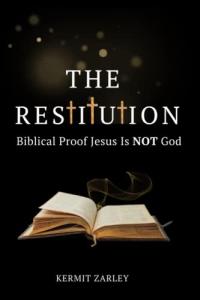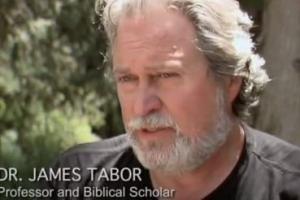Dr. James Tabor is a friend of mine who holds the position of Chair of Religious Studies at the University of North Carolina at Charlotte. (His colleague there is the well-known Dr. Bart Ehrman who specializes in textual criticism of the New Testament with six New York Times bestsellers.) Dr. Tabor’s endorsement of my book, The Restitution: Biblical Proof Jesus Is Not God, appears first among others on my book’s back cover. It says, “A mortal wound to the doctrine of the Trinity. . . . a towering work that will stand for a long time [to come].”
 Sean Finnegan is another friend of mine who is a pastor and consulting editor of 21st Century Reformation Online. At Sean’s website, restitutio.org, contributing writer Matthew Elton relates about a two-part lecture series Dr. Tabor has done entitled “Death and the Afterlife.” What little I know about it, it reminds me somewhat of the excellent classic text by Dr. Alan F. Segal entitled Life and Death: A History of the Afterlife in Western Religion. This book should be especially enlightening to the average Christian because of the dominant and false view that is taught in Christianity about the soul being immortal and that upon death, Christian souls immediately go to heaven to enjoy conscious bliss.
Sean Finnegan is another friend of mine who is a pastor and consulting editor of 21st Century Reformation Online. At Sean’s website, restitutio.org, contributing writer Matthew Elton relates about a two-part lecture series Dr. Tabor has done entitled “Death and the Afterlife.” What little I know about it, it reminds me somewhat of the excellent classic text by Dr. Alan F. Segal entitled Life and Death: A History of the Afterlife in Western Religion. This book should be especially enlightening to the average Christian because of the dominant and false view that is taught in Christianity about the soul being immortal and that upon death, Christian souls immediately go to heaven to enjoy conscious bliss.
I believed this way for decades because that is what almost all Christians are taught. But in the late 1980s, I attended a biblically-based conference in Houston, where I lived, that was about resurrection. It was sponsored by a Christian group from London who had a magazine entitled Resurrection. At that conference, I became convinced that what I had been taught about the afterlife was wrong, that it came from Greek philosophy, and I have believed ever since that these Christianx were right. It is that human souls are not immortal, but on death they go to Sheol to await resurrection. The word Sheol appear 67 times in the Hebrew Bible (=Old Testament). I believe it is a mistake for English Bible versions to translate sheol in the Hebrew Bible with another word, often “grave.” Instead, Sheol is a place name and thus should be transliterated, that is, left as it is.
For example, in the Hebrew Old Testament verse that is often quoted in the New Testament to refer to Jesus’ resurrection from the dead, which is Psalm 16.10 (e.g., Acts 2.31; 13.35) sheol appears in that Hebrew text. In English Bibles, that word sheol in Psalm 16.10 is transliterated in the ESV and NASB, but in the NIV it is translated “grave.” The KJV translates it “hell,” which is at least better than “grave.”
There is a good reason for that translation “hell” in the KJV. The very ancient Greeks and many peoples in antiquity believed in what was often called “the underworld.” It referred to “the place of the dead,” meaning that is where human souls go at death. The Greeks also called it “Hades.” The word hades appears in the Greek New Testament twelve times, and, interestingly, Jesus is presented as the speaker of it in all but one of those occasions. The Greek’s Hades corresponds to the Hebrews’ Sheol, thus referring to the same place. Where is it? The Old Testament often relates that it is located deep inside the earth. Jesus indicated that when he prophesied concerning his death and resurrection, “For just as Jonah was three days and three nights in the belly of the sea monster, so for three days and three nights the Son of Man will be in the heart of the earth” (Matthew 12.40).
BTW, three days and three nights is a Semitic idiom meaning third day. Also, Mel Gibson may be releasing his new film about Jesus’ resurrection as a sequel to his “The Passion of the Christ” next Easter. But it reportedly will contain much imagination about Jesus’ soul being in Sheol between his death and resurrection.
Back to Dr. James Tabor, Matthew Elton relates the following from the second part of Tabor’s series about “Death and the Afterlife:”
“Sometime before the 5th century B.C., an idea came from the East, possibly from India… I call this ‘the idea that took over the world.’… and the idea is that this world is not where human souls belong…. Plato’s allegory of the cave, as well as archaeological texts on golden [burial] plates, begin to give us a hint of this idea emerging in Greek thought, so that by the 5th century B.C. this idea appears to be widespread throughout the Greek world. Around this time, we see a shift in the way people viewed the world, and the shift is profound. It’s actually a complete reversal. Prior to this, it was assumed that this world is real and is good, and death is bad. But around the 5th century B.C., a shift occurs. Now, this world is not even the real world. Far from being good, this world is only a shadow of the good world. Heaven alone is your home, and you are an immortal soul trapped in a body, just like the men trapped in Plato’s allegory of the cave… this idea came from Eastern reincarnation philosophy. In the Phaedo, you get the idea that Socrates believes that he might have had many lives in the past, perhaps as a fish or as a bird (see Empedocles who foreshadowed the emergence of reincarnation philosophy long before Plato), but now that he spent his life seeking truth and enlightenment, he’s ready to ascend and be with the gods: ‘it is as certain as anything can be, that the soul is immortal and imperishable, and that our souls will really exist in the next world.’… Isn’t this shift amazing? In Homer’s time, even though there might be a blessed reward for the dead such as Elysium or the Isle of the Blessed, on the whole, death is bad. Death is a descent to Hades, a place markedly worse than Earth. But, by Plato’s time, the great shift has occurred. Now, death is life. Death is birth. And birth is death… It’s the total opposite of Genesis 1. In Genesis 1, there’s light and life and all the creation and everything is pronounced good, six times: good, good, good, good, good, and the last time is ‘very good’. All that God made is good. This positive view of the world. That the world is the place to be. The world is our home. Gilgamesh is told: ‘Rejoice with your wife and dance and drink and be merry because life is what you’ve been given, you’re not a god, and you will eventually die and go into the land of no return, the house of dust.’… And this view that the Earth and life are good, and death is bad, was the dominant view in the ancient world, until what I call ‘the great Hellenistic reversal’ around the 5th century B.C., when humans who belong on Earth began to believe that they actually belong in heaven, and this world is merely a dark shadow of existence. That may not be your view, but it’s a view that literally takes over the world and exerts strong influence on all western religions: Judaism, Christianity, and Islam. It’s also the foundation of lots of New Age thinking. It’s an idea that’s very common in our day with karma and reincarnation and this whole idea that this world is merely a school in which we are to learn something, but not the real thing. Then, at death, if we have gained the gnosis or knowledge needed, we can then advance and move on to the real world.”


















